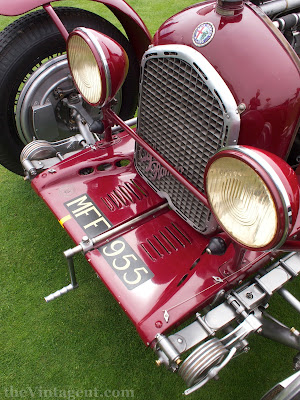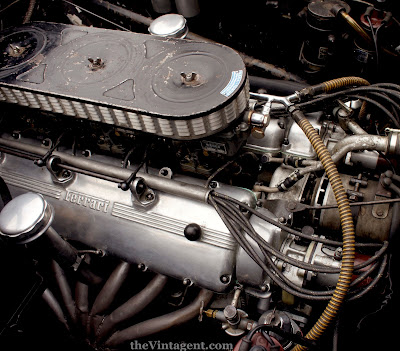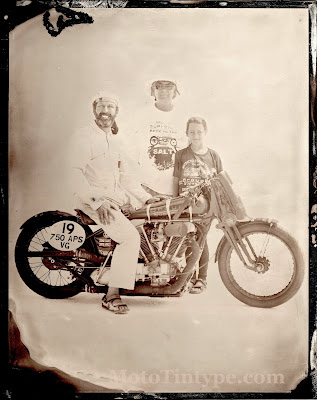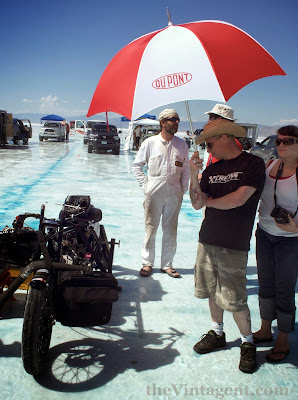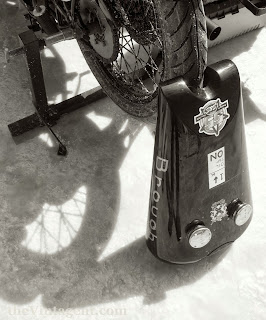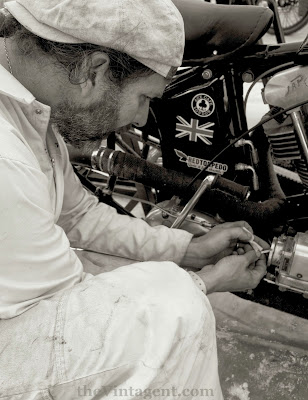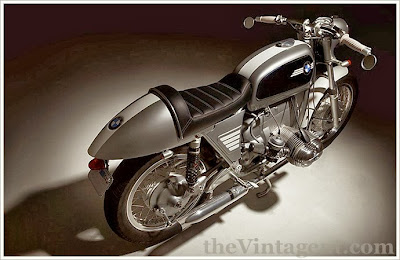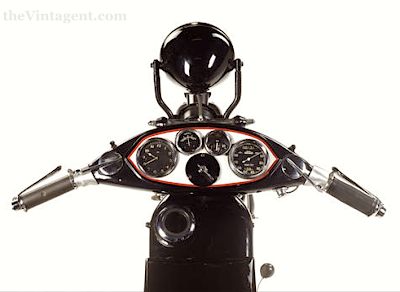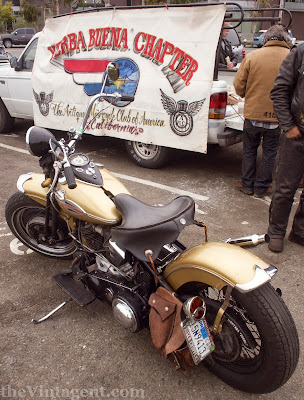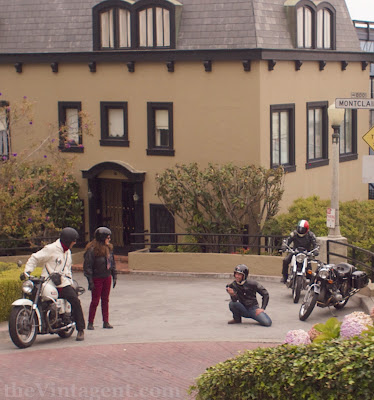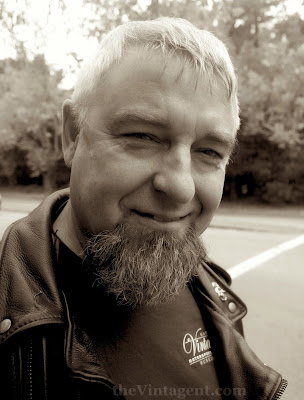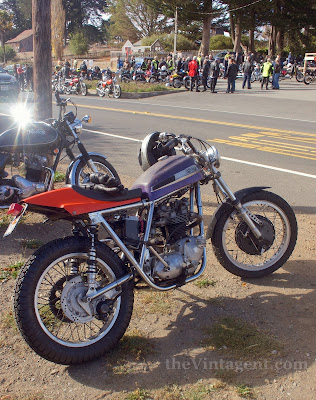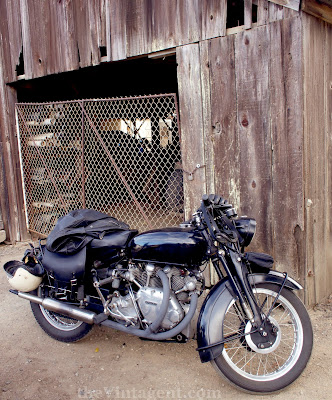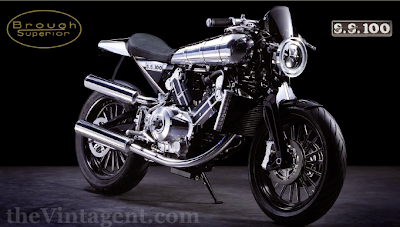Cyril Pullin was a rare bird among the many fascinating motorcycle inventors of the early 20th Century; while there were many rider-designer-manufacturers during the era, he is one of 4 men who not only designed, built, and raced motorcycles, but also won the
Isle of Man TT, a distinction he shares only with
Howard R Davies (HRD) and Charlie and
Harry Collier (Matchless).
![]() |
| Cyril Pullin in the 1913 Isle of Man TT, aboard an inlet-over-exhaust Veloce, on which he finished dead last, due to oil leaks and belt slippage... |
Pullin began his racing career at Brooklands and at the Isle of Man in 1913, racing the first iteration of a Velocette (and finishing dead last), but the next year he moved to a Rudge, which he modified to suit his jockey-like stature. He lowered the top frame rail of his Rudge 'Multi', which not only gave a lower seating position and consequently lower center of gravity, but also updated the appearance of a typical 'Teens '5-bar gate' frame design, with parallel top frame tubes and tall saddle position.
![]() |
| Winner of the 1914 Isle of Man TT on a Rudge Multi, Cyril Pullin modified the machine to his own specification |
After
Indian's 1911 1-2-3 sweep of the Isle of Man TT using two-speed chain drive machines, it was clear to all that multiple speeds equalled race success. Rudge and Zenith both built successful belt-drive racers using variable pulley diameters, and mechanical contraptions to take up the slack of the consequent belt looseness. While Scott used a 2-speed chain drive to win the 1913 TT, the Rudge Multi system had notches in its shift gate for 20 speeds, which did the trick in 1914, as Pullin beat
Howard R Davies (Sunbeam) and
Oliver Godfrey (Indian) to the line by 6.4 seconds, averaging a remarkable 49.5mph on the rutted, unpaved cart track of the island.
Rudge hoped to cash in on his success, and released a 'TT Replica' within the year.
Pullin had an extremely inventive mind, and in 1916 submitted the first of 171 patents (at least, so far as I've found!) filed during his lifetime, concerning all manner of carburation, oil pumps, frame and fork design, brakes, etc. By 1920 he teamed up with Stanley Lawrence Groom on the design of a radically advanced two-stroke motorcycle with a pressed sheetmetal frame. This machine was the subject of 12 joint patents in Pullin/Groom's names, and drawings of the machine show clearly the forward thinking of this pair of designers. While the two-stroke design failed to materialize, many of the ideas for its chassis reappear later in the 1920s with the Ascot-Pullin, as does the team of Pullin and Groom.
![]() |
| The 1920 two-stroke design of Pullin and Groom, with pressed-steel chassis |
By 1922 Pullin was employed by Douglas in Bristol, and his sister had married that marque's chief designer and General Manager, Steven Leslie Bailey, and was soon racing Douglas machines in their heyday, while patenting many of the ideas he developed there. In 1922, he became the first man to record 100mph on a motorcycle on British soil, using a very special OHV Douglas flat-twin. He also continued to race at Brooklands and the Isle of Man, taking place in the 1923 TT, which Douglas won both the Senior TT (Tom Sheard) and newly introduced Sidecar TT (Freddie Dixon, using a banking sidecar of his own design). Douglas, in its run of success, hired professional racer Rex Judd for a run of Brooklands records, and Pullin, ever the modernist, rigged a radio communications system with his rider, Judd having earphones within his helmet, from which he could communicate with Pullin back at the works garage - surely a first!
![]() |
| Cyril Pullin aboard the special racing Douglas on which he rode 100mph for the first time in Britain, in 1922 |
Even during these heady, successful days with Douglas, Pullin had a restless mind, and it seems the pull of his Great Idea - the pressed-steel motorcycle chassis - was too much to ignore. By 1928, he teamed up with Stanley Groom once again, and secured the old Phoenix factory in
Letchworth, Herts, to establish the Ascot Motor and Manufacture Co Ltd. Their intention was to produce both a car and motorcycle of steel pressings, the car being based on the
Hungarian 'Fejes', whose inventor, Jeno Fejes, held similar views to Pullin's own, although the car was far more radical than Pullin's designs, having even the engine built of welded-up pressings! The Fejes car (and what an unfortunate name...) was never actually built at the Ascot works, but Groom and Pullin drew up a flurry of patents (22 in all) relating to their two-wheeled venture, many of which found their way into the
Ascot-Pullin motorcycle.
![]() |
| The press release for the prototype Ascot-Pullin motorcycle, claiming a 100mph top speed |
The bright dream of a motorcycle inventor/racer could be forgiven if it looked like a camel, but Cyril Pullin had already proved with Rudge and Douglas that he had a designer's eye, and his sketches for the 1920 pressed-steel two stroke show a deep appreciation for aesthetic engineering. The
Ascot-Pullin proved to be far more than a 'slide-rule special', having a perfection of line and proportion revealing its designers to be men inclined towards elegance; the complete machine is a gem of the English Art Deco design movement, being the happy integration of modern machinery and contemporary style. It's pressed-steel bodywork is at once more restrained than its extravagant contemporary rival, the French 'Majestic'
[read my road test here], yet more cheerful than the sober Deco inclinations of the BMW R16
[read my road test here].
![]() |
| Yes, one of 7 survivors, but gassed up and ready to go! |
I was lucky enough to acquaint myself thoroughly with a 1929 Ascot-Pullin this summer, its indulgent owner giving me a free hand to explore the machine's character, regardless that it's one of perhaps 7 survivors. My first impression of the machine is one of unity - an easy summary given the monococque chassis - and luxury. The machine is beautifully appointed with every gauge one could hope for on a late '20s car of the era, an appropriate comparison given the 'two wheeled car' ideal Pullin was clearly shooting towards. This notion of and 'ideal' motorcycle with fully enclosed mechanicals, silent running, full instrumentation, and weather protection (not to mention an adjustable windscreen and wiper - an option on the Ascot-Pullin!) was an idea constantly referenced in the motorcycling press of the day, and which proved to be absolutely correct, 50 years later with the Honda Gold Wing and its ilk.
![]() |
| The pressed-steel forks and hydraulic brake lines are clearly visible here |
Pullin's baby bristles with both innovation and attractive design touches, like the numerous chromed star washers and a rocket-ship exhaust system. The engine is an advanced flat-single cylinder design, much like the contemporary
Moto Guzzi but OHV, and with a geared primary drive to its en-bloc transmission. As noted, the chassis and forks are pressed steel, with strengthening indents accented with two-tone paint, while the wheels are interchangeable on Pullin's own quick-release patented hubs, complemented by his own-patent hydraulic brakes, the first on a motorcycle. The symmetrical instrument binnacle holds a speedo, clock, oil pressure gauge, multi-position light switch, ammeter, and unique mirror-image levers for the magneto and air controls. The bike sits on Pullin's patented telescoping center stand, which has 2 positions - parking and 'wheel removal'. There's plenty of room for tools in the tanktop toolbox, and access for mechanical adjustments is easy, via removable panels.
![]() |
| The OHV cylinder head and exhaust 'rocket' tip; the cylinder head is a neat and robust design with cast-in rocker supports, but exposed valve gear |
With such elaborate specification, the Ascot-Pullin still only weighs in at a bit over 320lbs, and the saddle height is low at just over 26". The engine isn't a racer, as evidenced by a fairly low compression ratio, and consequent easy kickover. The beast starts with a woffle from its twinned exhausts, and the slow-scroll internal throttle reminds the rider that one needn't be in a hurry on such a fine piece of machinery. Pullin's own press releases claimed a 100mph top speed for the Ascot-Pullin, but that's not the impression I got - probably in the 80s is more accurate - and over every speed, the extra-low center of gravity from the flat-single mass gives stable and secure handling, which gave me complete confidence approaching the S bends of my testing grounds. Still, Pullin didn't build this machine as a scratcher, and hard cornering will leave souvenirs of expensive chrome on an unappreciative pavement. Scrubbing off speed with those novel hydro-brakes was as about as good as any 1920s bike I've ridden, which is to say, plan your stops and leave room for surprises. Enjoy the feeling of extreme quality this machine exudes; luxury motorcycles went extinct by WW2, and the Ascot-Pullin is as good as any on the road in its day.
![]() |
| 8-day Jaeger clock, ammeter, oil pressure gauge, lighting switch, speedo and fuel level gauge (in tank below) are all within easy sight. The speedo will apparently require some attention by the new owner! |
Cyril Pullin's two-wheeled brainchild was an idea too far ahead of its time, but he was absolutely correct in his ideas. Today we see examples ticking the boxes of his spec sheet on every highway, with stereos blaring from weather-protecting fairings, and engines invisible under shapely steel (or more likely plastic) car-like coverings. In the heady year of
1929, the Crash which greeted the Ascot-Pullin meant its doom, the factory closing its doors a year later, after an estimated 500 machines had been produced. Pullin went to work for Douglas once again, before setting off into the skies with his new interest; helicopters. His son Raymond became the first pilot of a British built helicopter, designed by his father, in 1938, and Pullin carried on in the aero industry the rest of his working life. A few examples of his motorcycle masterpiece remain, and it was sheer pleasure to sample the unfettered ideas of one of motorcycling's greatest figures.
![]() |
| The 'offside' showing access panels for maintenance |
My test machine is coming up for auction at the
Bonhams Stafford sale, on October 20th. Click here for more information.![]() |
| The clutch quick-thread release, magneto, and kickstart quadrant are easily exposed |
![]() |
| The dash in its entirety, showing the matched Deco ignition and air levers |
![]() |
| 1928 Patent for the chassis design, showing the halves to be welded together |
![]() |
| Cyril Pullin's 1928 patent for a telescoping center stand |
![]() |
| Pullin's patent for hydraulic motorcycle brakes and master/slave cylinders |
![]() |
| The beautiful Ascot-Pullin, an Art Deco gem |
Sign up here for free email delivery of TheVintagent!











